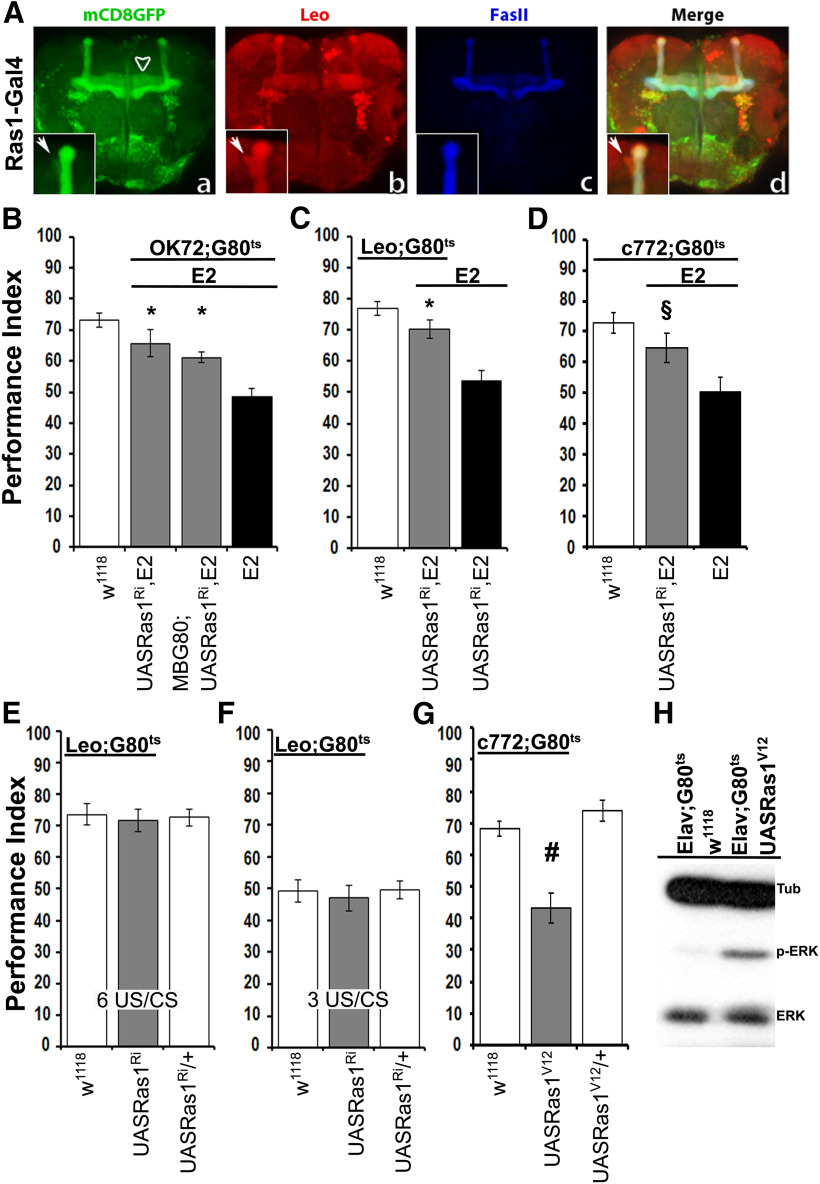Figure 6.
Ras1 hyperactivation in the MBs contributes to the learning deficiency of dNf1 nulls. A, Confocal images illustrate the distribution of Ras1 in the MBs of adult flies. Ras1-Gal4 drives the expression of UAS-mCD8GFP, especially in the α/β MB lobes (Aa–Ad), the γ lobe (Aa, arrowhead), and at lower levels in the α/′β′ lobes, where it colocalizes with Leo that marks all MB lobes (Aa,Ab,Ad, arrow in the marked boxes). Marked boxes represent higher magnification of the α/α′ lobes. B–G, Performance assessment after conditioning in control (white bars), mutant (black bars), and experimental (gray bars) animals. The genotypes of all animals are indicated below each bar. Data are mean ± SEM. G80ts indicates the ubiquitously expressed temperature-sensitive Gal4 repressor Tub-Gal80ts. B, Adult-specific dRas1 abrogation within the OK72 marked neurons at the exclusion of MB expression (second gray bar) partially restores learning in dNf1E2 homozygotes. *Statistically significant difference of the experimental from mutant flies. C, dRas1 abrogation in MB neurons (Leo-Gal4 driver) during adulthood rescues the dNf1E2 learning deficits. *Statistically significant difference of the experimental from mutant flies. D, dRas1 abrogation in MB neurons (c772-Gal4 driver) during adulthood improves the dNf1E2 learning deficit. §Statistical difference of the experimental from the mutant flies (p = 0.0312). E, F, Adult-specific abrogation of Ras1 (UASRas1Ri) in MB neurons does not yield learning deficits in control flies. The performance of animals with reduced Ras1 within MBs was not significantly different from that of controls both after 6 (E) and 3 (F) CS-US pairings. G, Overexpression of the constitutively active Ras1 (UASRas1v12) in the MBs of WT adult flies yields learning deficits. #Statistically significant difference of the experimental from the control groups. H, Representative Western blot of head lysates from adult flies expressing pan-neuronally a constitutively active form of Ras1 (UASRas1v12) under Elav-Gal4;Gal80ts using an antibody against phosphorylated ERK (p-ERK), revealing elevated active kinase compared with control animals. The amount of total-ERK protein is not affected. The genotypes of animals used are indicated above the immunoblot. Tubulin levels serve as loading control.

